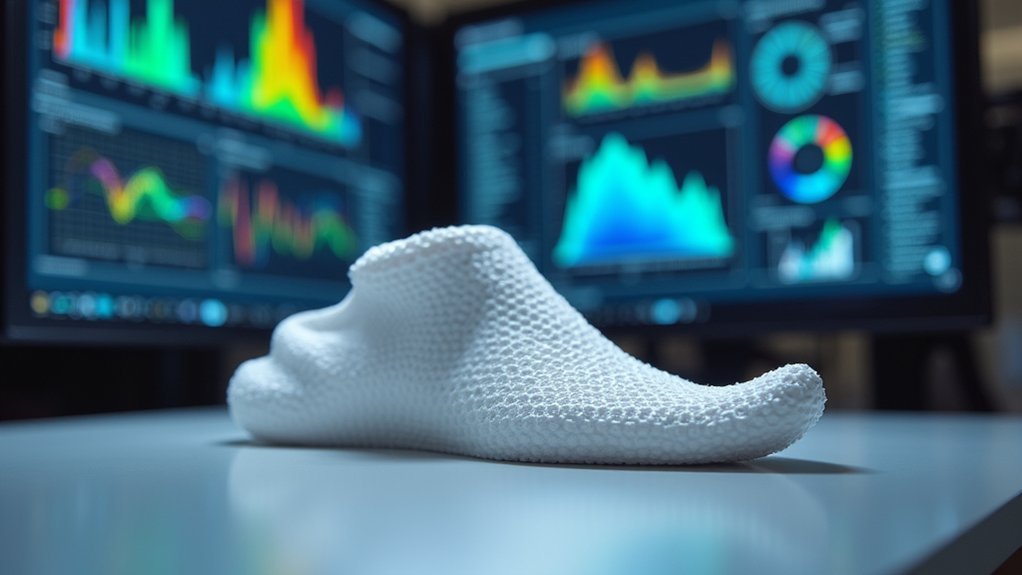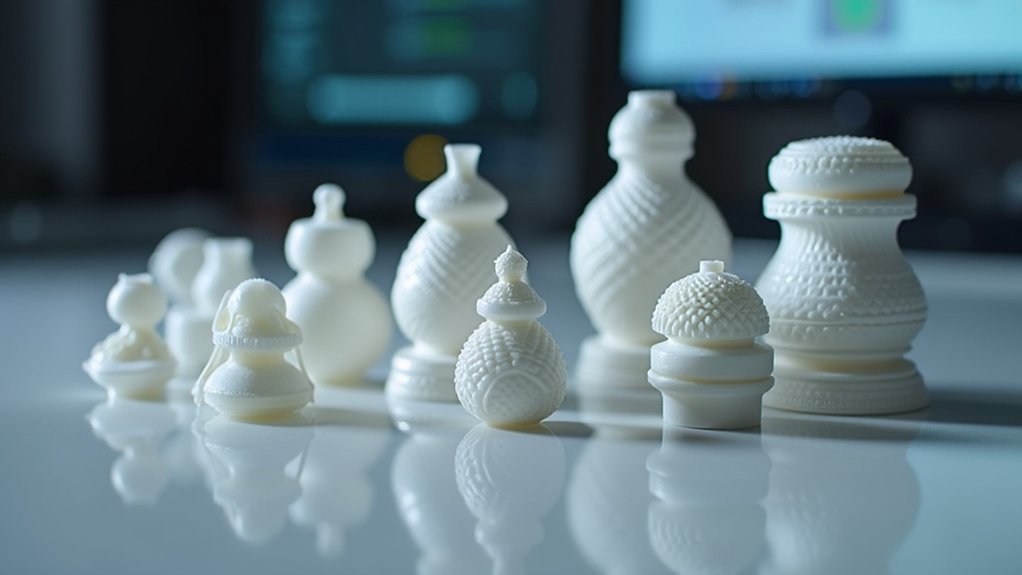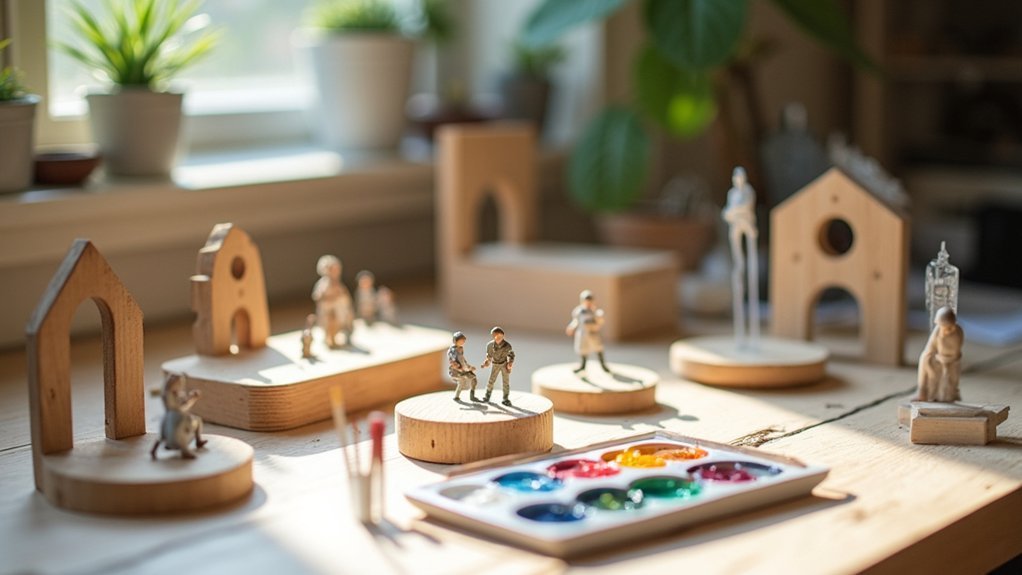You can scale STL files using seven proven methods: scale directly in Cura slicer by pressing ‘S’ and adjusting percentages uniformly, use CAD software scaling before STL export for superior precision, apply uniform scaling factors across X, Y, and Z dimensions to maintain proportions, convert units from inches to millimeters during export to prevent sizing errors, utilize mesh analysis tools like Meshmixer for post-scaling validation, implement parameterized CAD models for flexible adjustments, and manually resize critical features like hinges and connectors. Master these techniques to discover advanced scaling strategies.
Scale STL Files Directly in Cura Slicer Software

When you need to adjust your model’s size without switching between different software applications, Cura’s built-in scaling tool provides a straightforward solution.
You’ll find the scaling tool by selecting your model and clicking the second icon in the left toolbar, or simply press ‘S’ on your keyboard.
To scale the model effectively, adjust the X, Y, and Z percentage values in the tool window. Keep ‘Uniform Scaling’ activated to maintain proper proportions.
Maintain uniform scaling when adjusting X, Y, and Z values to preserve your model’s original proportions and avoid distortion.
When working with multiple models, hold Shift to select them simultaneously before applying changes.
Exercise caution when scaling down, as thin features might become unprintable. Always verify wall thickness meets minimum requirements after scaling.
Since STL files lack unit information, double-check your slicer’s dimension interpretation to avoid unexpected sizing issues.
Use CAD Software Scaling Tools Before STL Export
While Cura’s scaling features work well for minor adjustments, utilizing your CAD software’s scaling tool before STL export offers superior precision and control over dimensional changes.
You’ll achieve better accuracy by adjusting dimensions within your original CAD environment where you can leverage advanced measurement tools and constraints.
Set your scaling tool to match your slicer’s unit system, typically millimeters, to prevent import discrepancies. Always apply uniform scaling across all dimensions to maintain structural integrity and avoid weak points in your printed piece.
Take advantage of parameterization features to create adjustable scaling variables, making future modifications simpler without complete redesigns.
Before exporting, thoroughly review your scaled model to guarantee no features become too thin or intricate for successful printing after dimensional adjustments.
Apply Uniform Scaling Factor for Proportional Resizing

Although non-uniform scaling might seem like a quick fix for adjusting specific dimensions, applying a uniform scaling factor across all three axes guarantees your model maintains its proportional relationships and structural integrity.
When you scale your model, use identical percentages for X, Y, and Z dimensions—like reducing everything by 50%—to preserve the original design’s shape and prevent distortion.
This approach proves especially critical for intricate details that could become unprintable if disproportionately resized. You’ll find uniform scaling options in slicing software like Cura, making adjustments straightforward.
However, after scaling, you should manually verify that all features meet minimum wall thickness requirements, as even proportional resizing can affect printability of delicate components.
Convert Units From Inches to Millimeters During Export
Most scaling issues in 3D printing stem from unit mismatches between your CAD software and slicing programs. When you’re designing in inches but need to export for slicing software like Cura, you’ll face compatibility problems since most slicers assume STL files use millimeter measurements.
The solution lies in your CAD program’s export settings. In Autodesk Inventor and Fusion 360, you can specify millimeters as your export units, automatically converting your inch-based design to the correct scale. This prevents the common scenario where your slicing software misinterprets your model’s dimensions.
Since STL files don’t store unit information, proper export conversion guarantees your 3-inch model becomes 76.2mm rather than an incorrectly scaled 3mm object in your slicer.
Utilize Mesh Analysis Tools for Post-Scaling Validation

After scaling your STL model, you’ll need to verify that all features remain printable using mesh analysis tools. Scaling can create areas that fall below minimum wall thickness requirements, potentially causing print failures or structural weaknesses.
Mesh analysis tools like Meshmixer’s thickness analysis provide visual feedback highlighting problematic regions. These tools help you identify critical components requiring manual adjustments before printing.
Key benefits of mesh analysis tools include:
- Visual thickness mapping – Color-coded displays show areas below minimum thickness thresholds
- Density analysis – Identifies regions with insufficient material for stable printing
- Critical feature detection – Pinpoints intricate details that may not survive the printing process
- Quality assurance – Prevents failed prints by catching issues during pre-processing
Regular mesh analysis during scaling greatly improves your print success rate.
Implement Parameterized CAD Models for Flexible Scaling
You’ll find that setting up parameter-driven designs transforms your scaling workflow by defining variables for each critical dimension upfront.
When you establish these variables strategically, you can adjust entire models with simple value changes rather than manually modifying individual features.
Managing constraints effectively guarantees your scaled models maintain proper proportions while automatically enforcing minimum thickness requirements for successful printing.
Parameter-Driven Design Benefits
When you implement parameterized CAD models, you’ll transform how you approach scaling for 3D printing by establishing a flexible foundation that adapts to dimensional changes with minimal effort.
Parameter-driven design benefits include streamlined workflows where you modify single variables instead of countless individual dimensions. Your designs maintain uniform scaling across all components, preventing compatibility issues that plague manually adjusted models.
- Consistent wall thickness: Automated scaling preserves critical structural dimensions throughout your design
- Time efficiency: Complex parameterization requires initial investment but dramatically reduces future modification time
- Built-in constraints: If/then scenarios enforce minimum size requirements, maintaining printability during scaling operations
- Enhanced flexibility: Future design iterations become effortless when your foundation supports variable-driven modifications
You’ll discover that strategic parameterization eliminates scaling headaches while ensuring your prints maintain structural integrity.
Variable Setup Strategies
Strategic variable setup forms the backbone of effective parameterized scaling systems in CAD software.
You’ll want to incorporate scaling variables into each parameter from the start, allowing you to scale model components efficiently without losing printability. Create a master scaling factor that controls your entire design, then link individual dimensions to this variable.
Utilize if/then scenarios in software like Fusion 360 to enforce minimum size constraints. This guarantees critical features remain viable after scaling operations. For example, set minimum wall thickness parameters that override scaling when dimensions become too small for printing.
Remember that complex parameterization increases your initial workload but pays dividends later.
You’ll still need manual verification post-scaling to confirm all dimensions meet 3D printing requirements.
Constraint Management Techniques
Effective constraint management transforms your parameterized models from simple scaling tools into robust design systems that maintain functionality across all size variations.
You’ll need to establish minimum size thresholds that prevent features from becoming unprintable, while your scaling variables work within defined boundaries to preserve critical dimensions like wall thickness and clearances.
Setting up if/then scenarios in your CAD software automatically enforces these constraints during scaling operations. This approach guarantees that when you scale down a model, essential features won’t fall below your 3D printer’s capabilities.
- Define minimum wall thickness constraints based on your printer’s resolution
- Create scaling variables that maintain proportional relationships between components
- Implement conditional statements that override scaling for critical features
- Set maximum scale limits to prevent structural integrity issues
Manual Dimension Adjustments for Critical Print Features
After scaling your STL file, you’ll need to manually verify that critical features maintain proper wall thickness requirements for successful printing.
Your scaled model might’ve reduced essential components below the minimum printable dimensions, requiring targeted adjustments to specific areas.
You can’t rely on uniform scaling alone—critical components like hinges, connectors, and thin walls need individual resizing to preserve both printability and functionality.
Wall Thickness Requirements
When you scale an STL file for 3D printing, you’ll often find that critical dimensions no longer meet your printer’s minimum requirements.
Wall thickness requirements become particularly challenging when scaling down models, as features that were originally printable can become impossibly thin. A wall that starts at 2 mm thickness might shrink to just 0.2 mm after aggressive scaling, making it unprintable on most FDM printers.
You’ll need to manually review and adjust these critical dimensions after any scaling operation:
- Check that all walls maintain at least 1-2 mm thickness for standard FDM printers
- Use mesh analysis tools like Meshmixer to identify problematic thin sections
- Simplify intricate details that can’t maintain structural integrity when scaled
- Prioritize functionality over exact proportional scaling for critical features
Critical Component Resizing
Beyond addressing general wall thickness issues, you’ll need to tackle specific components that require individual attention during the scaling process. Critical component resizing guarantees your STL file maintains functionality after dimensional changes. You’ll often find that hinges, connectors, and mounting points need manual adjustments to remain printable.
| Component Type | Original Size | Scaled Action |
|---|---|---|
| Hinges/Joints | 2mm pin diameter | Maintain 1.5mm minimum |
| Screw Holes | M3 threading | Keep standard dimensions |
| Text/Logos | 3mm height | Simplify or enlarge |
| Thin Brackets | 0.8mm thickness | Increase to 1.2mm |
When scaling down complex models, you’ll need to prioritize essential features over decorative elements. Consider combining small parts or omitting intricate details that become unprintable. This selective approach maintains your model’s core functionality while guaranteeing successful printing outcomes.
Frequently Asked Questions
How to Scale STL Files for 3D Printing?
You’ll scale STL files using slicer software like Cura by selecting your model and adjusting X, Y, Z percentage values. Always use uniform scaling to maintain proportions and check minimum wall thickness requirements after scaling.
How to Optimize STL for Printing?
You’ll optimize STL files by checking mesh integrity, fixing holes and non-manifold edges, adjusting resolution for detail balance, orienting models strategically, and adding supports where needed for successful printing.
Is STL Binary or ASCII Better for 3D Printing?
You’ll find binary STL files work better for 3D printing since they’re smaller, load faster in slicers, and process more efficiently than ASCII files, especially with complex models requiring professional-quality results.
How to Reduce STL File Size Without Losing Quality?
Use mesh simplification tools in your CAD software to reduce polygon count while maintaining visual quality. Export as .3mf format for better compression, or adjust STL resolution settings to balance file size with detail.





Leave a Reply